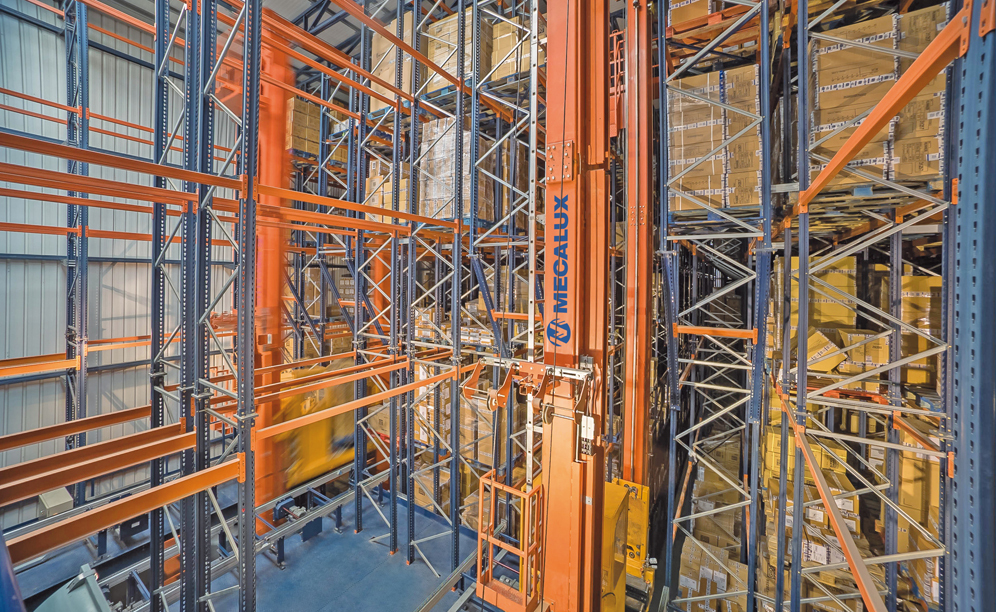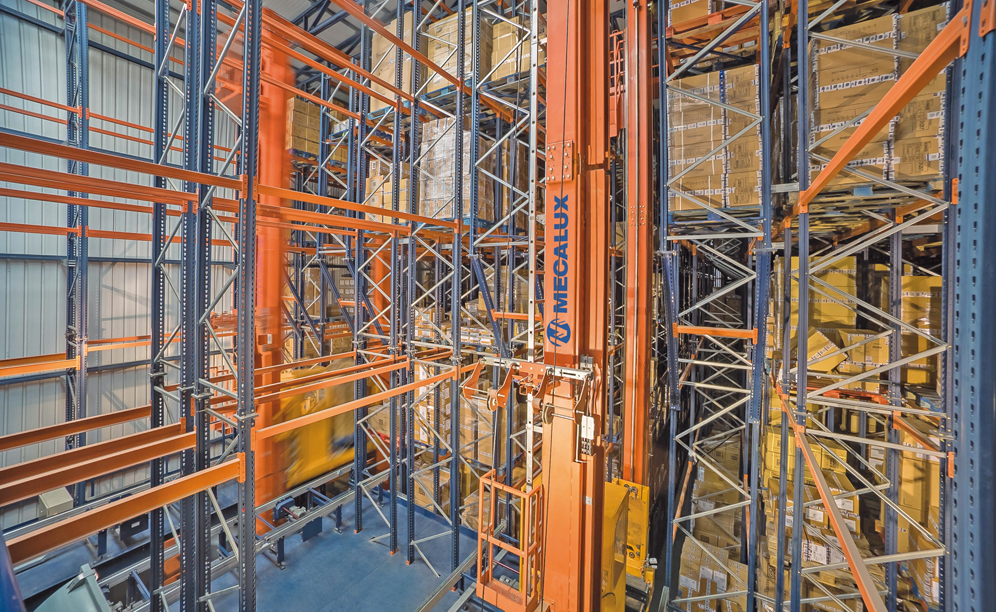
The automated clad-rack warehouse for pallets is composed of three aisles with double-deep racks on both sides

Gioseppo automates its most profitable logistics processes

Gioseppo's facility in Elche (Spain) is composed of an automated clad-rack warehouse for pallets, with live racks and a specific area for picking. The warehouse management system Mecalux Easy WMS was supplied, which is responsible for managing all the centre’s processes.
Founded in 1991, Gioseppo is a family business from the Elx region dedicated to designing and marketing medium to high-end shoes for men, women and child. After almost 25 years, Gioseppo is currently a well-established brand whose products are marketed in more than 60 countries worldwide.
Its growth and track record have led Gioseppo to be included in the prestigious ‘Forum for Renowned Spanish Brand’s’, an alliance made up of companies and leading brands from their respective sectors.
Logistical needs
The objectives presented by Gioseppo to Mecalux were very specific: build a warehouse to increase its storage capacity to locate all products coming from production, and automate the internal transport of goods with the purpose of managing a greater number of SKUs in the most efficient way possible.
With this, the company would take a qualitative leap forward on a logistical level that could reduce production costs, while improving warehouse productivity.
Based on these requirements, Mecalux designed an integrated solution in which automated storage processes were more profitable for Gioseppo.
Construction needs
Another premise that Mecalux had to keep in mind was to pay careful attention to the public image of the company. It was of utmost importance to limit the impact constructing a clad-rack warehouse would have on the landscape of the Gioseppo “Love Work Place” logistics centre, an environmentally friendly space near the Mediterranean Sea.
Accordingly, the dimensions of the logistics centre could not exceed a certain height. So, it was necessary to find a solution that offered high storage capacity, while at the same time reducing the facility’s size.
This 18.5 m high, 79 m long and 21.5 m wide clad-rack warehouse is composed of three aisles with double-deep racks on both sides, offering a storage capacity of 5,844 pallets, weighing 500 kg each. To be clad-rack means that the structure of the building is formed by the racks themselves, and that the outer cladding is supported and attached to them.
For structural calculations of clad-rack warehouses the following are taken into account: its own weight; the weight of the goods stored; the wind pressure both push and suction depending where it is built; the weight of the snow as indicated by the regulations; ramming by stacker cranes; and finally, the seismicity corresponding to the territory in which it is located.
Its purpose, as explained above, was twofold: to optimise height in order to achieve the largest possible storage capacity, and reduce landscape impact to preserve Gioseppo’s public image.
Inside the warehouse
In each aisle a stacker crane circulates, handling the movements of the pallets from the conveyors at the end of the aisle to its designated location.
The use of stacker cranes helps increase productivity, at the same time decreasing the resources required to manipulate the goods.
Inputs and outputs
The inputs and outputs of palletised goods are done via a double shuttle that connects the main circuit of conveyors with the storage aisles. The goods input area has an entry checkpoint, which is responsible for verifying that the size, weight, and condition of the pallets comply with the facility's specifications.
Picking functions
This same transfer car is tasked with transferring the pallets from the aisles to the P&D stations. The picking area is organised starting with six independent stations where operators take the boxes they need from the pallet and deposit them onto the box conveyor with the order sorter located on the back.
In addition, and in order to facilitate work, each picking station has a lift table so that the pallets are kept at the ideal height for each operator, improving its ergonomic position.
Live racks for orders completed and consumer products
A block of 36 live rack channels has been installed both for storing orders prepared, as well as the stacks of idle pallets.
This 8 m high, 9.5 m long and 11 m deep warehouse has a storage capacity of 324 pallets 800 x 1,200 x 1,900 mm in size, each with a maximum weight of 400 kg. Each channel receives nine pallets.
The live racks are a compact storage system that allows maximum use of space and that are composed of roller channels on a slight incline. The pallets are inserted into the highest part of the rack and move via gravity to the lower end, being available to the operator. The pallet travel speed is controlled by roller brakes.
Therefore, this storage system is ideal for lowering handling times and expedites picking, increasing the facility's productivity.
Easy WMS: the nerve centre of the warehouse
In Gioseppo’s new facility, the Easy WMS warehouse management system from Mecalux was implemented to manage and coordinate the different automated operations that take place within the building: the input and output of goods, storage, picking and dispatches.
This powerful management software has been customised to Gioseppo’s demands, being able to: locate pallets in the racks based on algorithms or parametrisable rules, manage outputs on the basis of traceability and FIFO criteria, check the stock, run standard and custom labelling of containers, group output orders in different modalities, etc.
Easy WMS (warehouse management software) provides a competitive advantage to Gioseppo, since it involves cost savings, an improvement in service quality and consequently, maximising warehouse profitability.
In addition, Easy WMS is in permanent communication with the SAP ERP, Gioseppo’s main management system, exchanging orders and the information that is essential for its overall management.
| Automated Warehouse | |
|---|---|
| Storage capacity :: | 5,844 pallets |
| Maximum weight per pallet :: | 500 kg |
| Warehouse height :: | 18,5 m |
| No. of stacker cranes :: | 3 |
| Type of stacker crane :: | twin-mast |
| Fork type :: | double-deep |
| Construction system :: | self-supporting |
Ask an expert